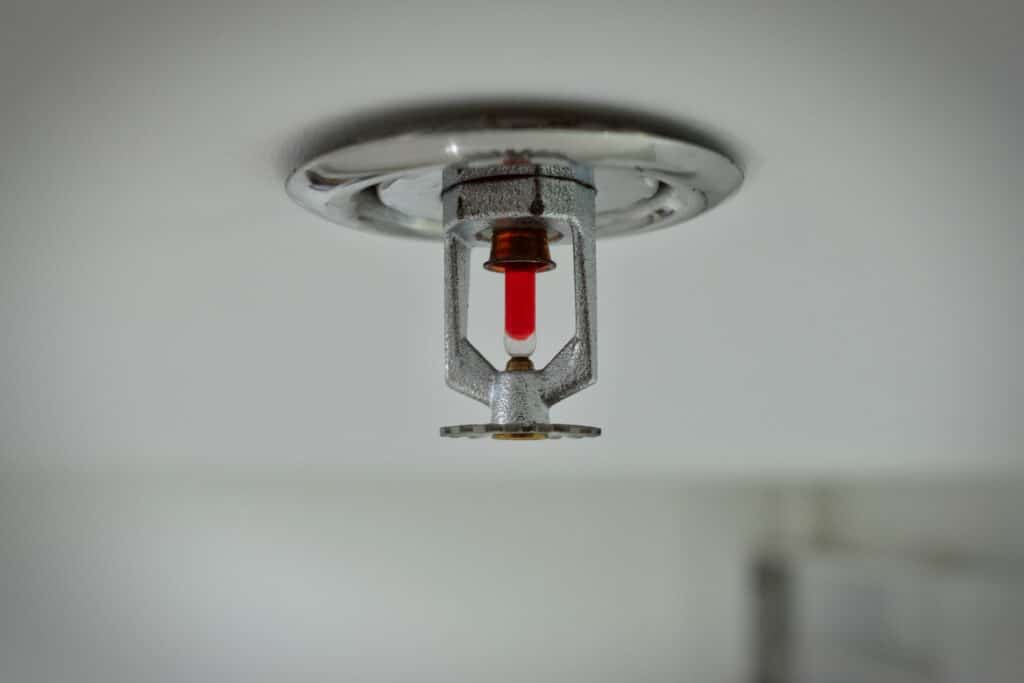Fire sprinkler systems provide a critical element of safety for business owners. A fire in a commercial facility could result in devastating consequences from serious injury to the deaths of employees or customers. It could also damage or destroy merchandise, vital records, and costly equipment, ultimately placing a company at risk for going out of business. Fire protection systems can help avoid these outcomes.
In the most simple of terms, a commercial fire protection system is designed to suppress and restrict the spread of a fire. Once activated by heat, the system engages, showering water over a particular area within a building in order to minimize damage, but more importantly, to maximum the time people have to get out of the building. The main goal of the sprinkler system is to compartmentalize (or better yet extinguish) the fire to give people more time to escape.
Commercial systems, as most are aware, differ significantly from that of residential systems, particularly in two main areas:
- Codes. Whether residential or commercial, systems are designed following the “300 consensus codes and standards intended to minimize the possibility and effects of fire and other risks” as set forth by the National Fire Protection Association (NFPA). Residential sprinkler systems are designed under NFPA 13R while commercial systems are designed under NFPA 13. Some other notable requirements include: “Standard of Portable Fire Extinguishers” (NFPA 10), “Standard for the Installation of Sprinkler Systems” (NFPA 13), “Standard for the Installation of Sprinkler Systems in Low Rise Residential Occupancies” (NFPA 13R), and the “Code for the Protection of Historic Structures” (NFPA 914).
- Design. There are multiple factors that impact the design. A residential sprinkler system is a bit more flexible as compared to that of a commercial one. For example, an apartment unit may only contain one sprinkler head to cover the entire living area or a bedroom, whereas a commercial system demands complete coverage of nearly any room – with a few exceptions for spaces created by architectural features. A residential system is also more relaxed on which rooms require a sprinkler head, one example being a walk-in closet.
Depending on the building’s occupancy classification, there are also different hazard classifications that impact the design of the fire protection system. Under NFPA 13, there are 5 hazard classifications:
- Light Hazard (office, church)
- Ordinary Hazard Group 1 (laundry, restaurant)
- Ordinary Hazard Group 2 (mercantile, post office)
- Extra Hazard Group 1
- Extra Hazard Group 2
The hazard classification will determine the protection area (in terms of square footage) per sprinkler head and the maximum spacing between heads. It also determines the gallons per minute (GPM) demand requirement over the area of sprinkler operation. In other words, the higher the hazard classification, the more sprinkler heads and/or water demand will be required.
Lastly, the design is also impacted by the system selected. Two of the most common are “wet” and a “dry” sprinkler systems. A wet system holds water in the piping at all times and is used in buildings/areas where the ambient temperature remains above 40°F at all times. On the other hand, a dry sprinkler system has no water present in the system piping. Instead, it contains air that is maintained at a lower pressure than the supply water until the system operates due to fire. This type of system is often found in structures such as parking garages.
Selecting the right system for your facility is paramount, especially when the stakes are so high. Contact our experts today and let us guide you through the process of protecting your greatest investments: your employees and your building.
_______________
VP Engineering is a top Charlotte-based MEP design firm offering engineering expertise in senior living, multi-family, hospitality, and retail/commercial markets worldwide. With experience in a wide range of building types, our MEP engineering services help keep projects on budget and achieve your goals. Learn more at vpce.com.



